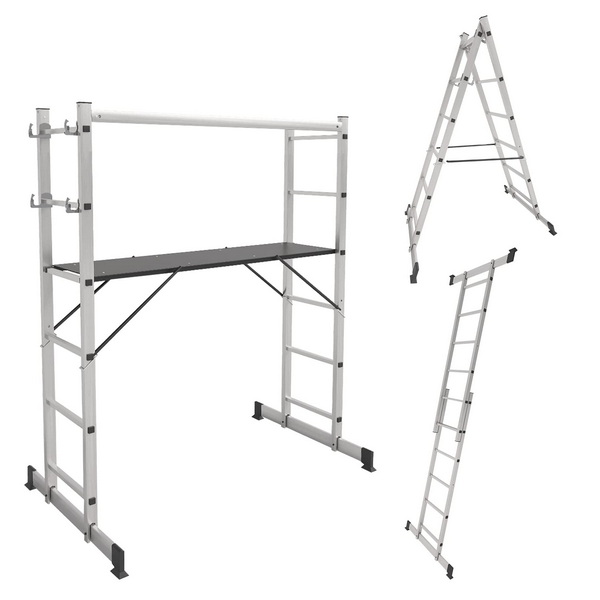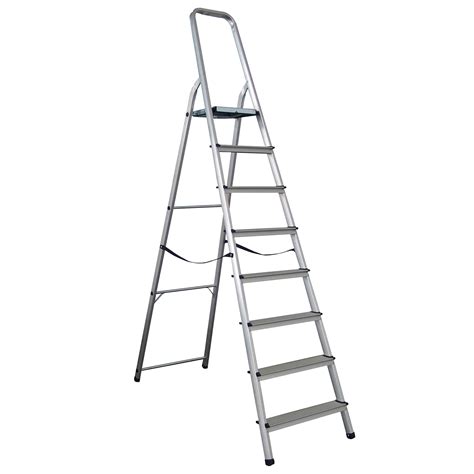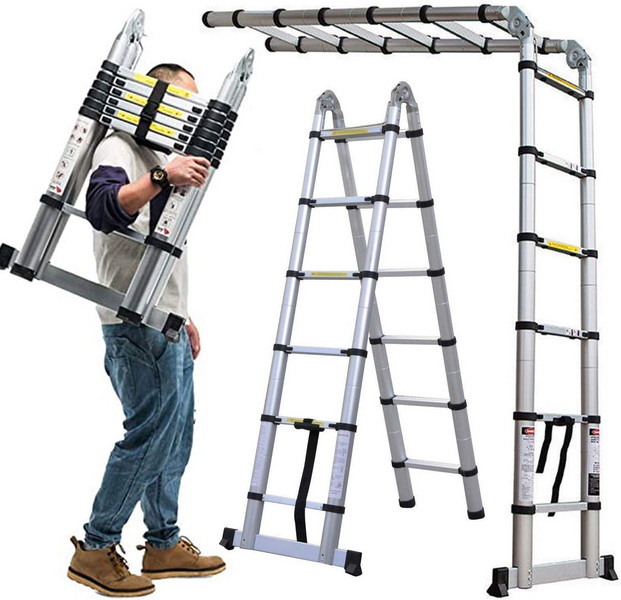Content Menu
● Introduction to A-Frame Ladder Scaffolding
● Key Features of A-Frame Ladder Scaffolding
● Safety Considerations
>> 1. Proper Setup
>> 2. Load Capacity
>> 3. Fall Protection
>> 4. Regular Inspection
>> 5. Proper Access and Egress
● Best Practices for A-Frame Ladder Scaffolding
>> 1. Manufacturer's Instructions
>> 2. Training and Supervision
>> 3. Environmental Factors
>> 4. Scaffolding Maintenance
>> 5. Team Communication
● Common Hazards and Solutions
>> 1. Plank Slippage
>> 2. Overloading
>> 3. Electrical Hazards
>> 4. Slippery Surfaces
>> 5. Tool Safety
● Advanced Safety Measures
>> 1. Scaffolding Tags
>> 2. Safety Nets
>> 3. Regular Audits
>> 4. Emergency Procedures
>> 5. Continuous Training
● Case Studies and Real-Life Examples
>> 1. Construction Site Safety
>> 2. Residential Maintenance
>> 3. Industrial Applications
● Conclusion
● FAQ
>> 1. What is the minimum platform width for scaffolding?
>> 2. How should I secure planks on A-frame ladder scaffolding?
>> 3. What safety equipment is required for working at heights above 10 feet?
>> 4. Can I use A-frame ladder scaffolding near electrical equipment?
>> 5. How often should I inspect A-frame ladder scaffolding?
● Citations:
A-frame ladder scaffolding is a versatile and practical solution for various tasks that require working at heights. However, safety should always be the top priority when using such equipment. This article will delve into the key safety tips for setting up and using A-frame ladder scaffolding effectively.

Introduction to A-Frame Ladder Scaffolding
A-frame ladders can be converted into scaffolding by separating the sides and using them as trestles with a plank. This setup allows for a stable work platform that can be adjusted to different heights. The Little Giant Ladder System is a popular example of this type of equipment, offering flexibility and ease of use.
Key Features of A-Frame Ladder Scaffolding
- Versatility: A-frame ladders can be easily transformed into scaffolding, providing a wide platform for working.
- Adjustability: The height and width of the scaffolding can be adjusted according to the task requirements.
- Stability: When properly set up, A-frame ladder scaffolding offers a stable working surface.
Safety Considerations
Safety is paramount when using A-frame ladder scaffolding. Here are some essential safety tips to consider:
1. Proper Setup
Ensure that the scaffolding is set up on a firm, level surface. Use adjustable screw jacks if necessary to maintain stability. Avoid using unstable objects like boxes or bricks to support the scaffolding.
2. Load Capacity
Always check the load capacity of the scaffolding and ensure it can support at least four times the intended load. Overloading can lead to structural failure.
3. Fall Protection
Use personal fall arrest systems (PFAS) or guardrails when working at heights above 10 feet. Ensure that all workers are properly trained in using these systems.
4. Regular Inspection
Regularly inspect the scaffolding for any damage or wear. Ensure all components are securely locked in place.
5. Proper Access and Egress
Ensure safe means of access and egress. Use ladder safety rules when climbing up or down from the scaffolding.

Best Practices for A-Frame Ladder Scaffolding
1. Manufacturer's Instructions
Always follow the manufacturer's instructions for setting up and using the scaffolding. For example, the Little Giant Ladder System has specific guidelines for converting the ladder into scaffolding.
2. Training and Supervision
Ensure that all workers are properly trained in the safe use of A-frame ladder scaffolding. Supervise inexperienced workers closely.
3. Environmental Factors
Be aware of environmental factors such as wind, rain, or ice that could affect the stability of the scaffolding.
4. Scaffolding Maintenance
Regularly maintain the scaffolding by cleaning and lubricating moving parts. This ensures smooth operation and extends the lifespan of the equipment.
5. Team Communication
Ensure that all team members are aware of the safety protocols and communicate effectively during setup and use.
Common Hazards and Solutions
1. Plank Slippage
Use secure locking mechanisms to prevent planks from sliding off the scaffolding.
2. Overloading
Monitor the weight on the scaffolding to prevent overloading. Use load charts provided by the manufacturer.
3. Electrical Hazards
Be cautious of overhead power lines and electrical equipment. Use non-conductive ladders when necessary.
4. Slippery Surfaces
Ensure that the scaffolding and surrounding area are free from slippery substances. Use non-slip mats or coatings if necessary.
5. Tool Safety
Secure tools and materials on the scaffolding to prevent them from falling and causing injury.
Advanced Safety Measures
1. Scaffolding Tags
Use scaffolding tags to indicate whether the scaffolding is safe for use. This helps prevent unauthorized access.
2. Safety Nets
Consider using safety nets under the scaffolding to catch falling objects or debris.
3. Regular Audits
Conduct regular safety audits to ensure compliance with safety standards and regulations.
4. Emergency Procedures
Establish clear emergency procedures in case of accidents or equipment failure.
5. Continuous Training
Provide continuous training to workers on new safety protocols and equipment updates.
Case Studies and Real-Life Examples
1. Construction Site Safety
In a recent construction project, A-frame ladder scaffolding was used extensively. By following strict safety protocols, the site reported zero accidents related to scaffolding use.
2. Residential Maintenance
For residential maintenance tasks, homeowners often use A-frame ladders. Proper setup and safety measures can significantly reduce the risk of accidents.
3. Industrial Applications
In industrial settings, A-frame ladder scaffolding is used for tasks like equipment maintenance. Regular inspections and proper training are crucial in these environments.
Conclusion
A-frame ladder scaffolding offers a convenient and versatile solution for working at heights, but it requires careful attention to safety. By following the key safety tips outlined in this article, you can minimize risks and ensure a safe working environment. Always prioritize proper setup, load capacity, fall protection, and regular inspections to prevent accidents.

FAQ
1. What is the minimum platform width for scaffolding?
The minimum platform width for scaffolding should not be less than 20 inches to ensure stability and safety.
2. How should I secure planks on A-frame ladder scaffolding?
Use locking mechanisms to secure planks to the scaffolding. Ensure that the planks are properly aligned and locked in place to prevent slippage.
3. What safety equipment is required for working at heights above 10 feet?
For heights above 10 feet, use personal fall arrest systems (PFAS) or guardrails to protect workers from falls.
4. Can I use A-frame ladder scaffolding near electrical equipment?
Avoid using metal ladders near electrical equipment. If necessary, use non-conductive ladders to prevent electrical shock.
5. How often should I inspect A-frame ladder scaffolding?
Regularly inspect the scaffolding before each use to ensure all components are in good condition and properly secured.
Citations:
[1] https://www.sfasu.edu/docs/safety/ladder-scaffolding-and-fall-protection-safety-program.pdf
[2] https://www.youtube.com/watch?v=2OhricCX38o
[3] https://www.labour.gov.hk/eng/public/os/B/mss.pdf
[4] https://osha4you.com/ladders/ladder-safety-dos-and-donts/
[5] https://www.reddit.com/r/OSHA/comments/6eg8aj/scaffold_made_from_a_plank_and_an_inverted_a/
[6] https://www.ihsa.ca/rtf/health_safety_manual/pdfs/equipment/Scaffolds.pdf
[7] https://www.scaffoldingsolutions.com/articles/11-scaffolding-safety-tips/
[8] https://www.youtube.com/watch?v=rHwVAudO1f8
[9] https://www.tdi.texas.gov/tips/safety/scaffolding.html






















